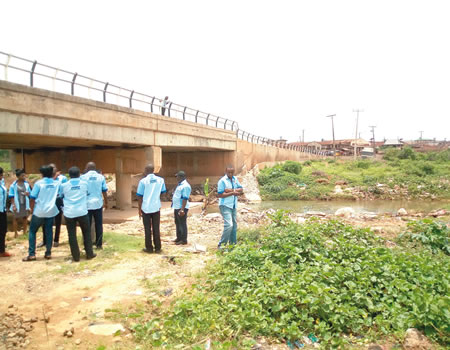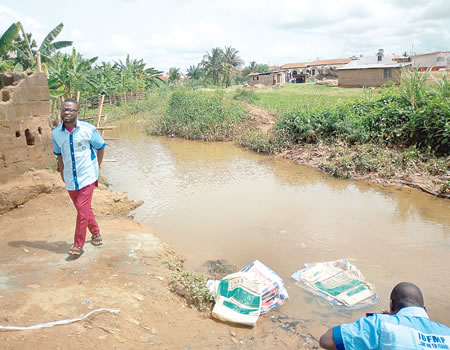The ancient city of Ibadan, West Africa’s largest metropolitan city is said to have a lengthy rainy season that runs between March and October with a history of flooding that has become a yearly disaster as a result of hydrological and anthropogenic factors. And according to data, Ibadan has witnessed several devastating flood incidents since 1933 and flooding has become a perennial occurrence but the August 26, 2011 has been adjudged to be the most destructive with monetary value of damages to property running into billions and many lives lost; a total of 39 bridges and culverts were damaged in the floods.
Flood according to Barweni, Tawari, and Abowei 2012, is the occurrence of excessive volume of water in areas not usually waterlogged and one of the major environmental crises that results in loss of lives, collapse of houses and markets, destruction of livestock and farmlands, giving rise to food shortage and starvation with health implications; polluted drinking water and resultant water-borne diseases.
A communication expert that researched flooding in Ibadan, Dr Adeyinka Laninhun, in a workshop stated that a study on flood vulnerability assessment of Ibadan showed that Mean Annual Rainfall (MAR) contributed more to flooding than other factors while indiscriminate dumping of solid wastes in streams and river channels, and construction of buildings in flood plains and across drainages remains a major factor.
Indeed, the World Health Organisation in 2000 stated that most diseases requiring hospital admission are water-borne or water-washed and this problem is often exacerbated by flooding and the 2011 Ibadan experience has led to many palliative measures from the state government.
The situation is however still at a critical stage as a 2015 report by the World Resource Institute (WRI) predicts that people that would be affected by flood globally would be over 54 million by 2030 from 21 million affected in 2015 and the National Emergency Management Agency (NEMA) also revealed that at least 20 per cent of Nigeria’s population is at risk of flooding annually following a research report that 84.4 per cent of deaths recorded in Nigeria between 1990 and 2014 were attributed to flood disasters.
Speaking recently, the Oyo state Commissioner for Finance, Bimbo Adekanmbi represented by the Permanent Secretary in the Ministry, Musa Olawoye, stated that though Ibadan has been witnessing flooding for a long time, successive governments in the state had merely been engaging in palliatives which amounted to redressing the damage done to hydraulic infrastructures and cushioning the losses to lives and properties without solving the fundamental causes of the menace.
The present administration in the state led by Senator Abiola Ajimobi while confirming that the events of August 26, 2011 would not be easily forgotten while inspecting the sites of flooding vowed that it will never happen again. And unlike his predecessors, Ajimobi decided to combat the menace by designing a comprehensive and deep rooted solution to the continuous challenge of curbing flooding and mitigating its effects.
The solution he came up with is the Ibadan Urban Flood Management Project (IUFMP), an initiative of the governor with funding support from the World Bank which is a special purpose vehicle to address all issues relating to flooding in Ibadan; reduce flood risks and improve solid waste management practices in Ibadan, increase knowledge of flooding and solid waste management, improve legal, policy and institutional environment for promoting desirable flood risk reduction behavior and improve flood risk reduction and waste management behaviors by individuals, households and businesses.
IUFMP also has the additional responsibility of working on the City Master Plan, the Flood Risk Management and Drainage Master Plan and the Solid Waste Management Master Plan. The governor’s idea is yielding results as IUFMP is already delivering masterpiece civil works across Ibadan to forestall a reoccurrence of the 2011 situation; it has dredged streams in about 67 locations, expansion of waterways and clearing of blocked drains.
Though major causes of flood disasters are deforestation, rapid urbanization, environmental degradation and climate change, Ibadan has the peculiar challenge that basically bothers on undue interference by man; lack of drainage systems, narrow gauge drainage, drainages blocked by new or extended buildings or accumulation of solid wastes in drainages, solid waste dumped into streams and river channels over time resulting in raised stream beds downhill or downstream which leads to culverts being blocked and water flow under bridges substantially constricted as well as blocking of waterways with construction and poor management of water resources.
And for people in Sasa-Osajin, Ola Adua, Ogbere-Pegba and Cele Rainbow, there is good news as they are already thanking the state government and IUFMP for its intervention which has made life easier on them. Before the IUFMP intervention, they had been cut off from surrounding communities after the 2011 flood but the situation is not the same now with the construction of a two by three double cell culvert and 400 metres approach road and metal embankment protection to curb indiscriminate dumping of waste while the residents of Ogbere Pegba got intervention in the form of a 2×15 span bridge with two phase railings and retaining walls while in Eleyele, there is a palliative in the form of repairing the spill way that is worn.
Today, major work is set to start in a few days in 13 locations that IUFMP have tagged as priority sites; Alaro in Sango, Believer’s stresam in Odo Ona, Omiri, Oke Ola Ayo in Olodo, Ojoo Arulogun, Foworogi, Elere, Abonde, MajeOgbere Moradeyo, Alaro 7up and Ebenezer in Alakia Isebo.
But in spite of these efforts, it’s still not yet uhuru on the issue of flooding in Ibadan. Research has shown that despite hydraulic interventions, human attitude may be a major reason for subsequent flooding as attitudinal factors have been said to be a major reason for flooding. Indeed Albert Einstein confirmed this when he stated that “we shall need a substantially new way of thinking if humanity is to survive.” Albert Einstein 1954
The residents also corroborated the fact that human attitude is a major issue. Though they are happy with IUFMP efforts, they confirmed that people continue to clog already dredged waterways with waste. Speaking with Nigerian Tribune, Pastor Rick Okogie, a resident of Sasa–Osajin stated that now that they are linked with other communities and the water now flows freely, they have to contend with people that drop waste.
“They come from other communities; you will just see a car pack and they dump waste and move on. This is why we have community monitoring, all of us around here ensure we stay outside till like midnight to keep watch,” Osagie said.
His point was corroborated by Kanisuru Mama Saidat at Ola Adua who added that since the culvert was constructed and water dredged, the community have been clearing the waterways and presenting people from dumping waste in a bid to complement government’s efforts and forestall a flood disaster.
Having identified that the media is a major stakeholder in flood mitigation and following research reports that the media is reactive rather than proactive (Nkwunonwo et al.2015; Ganiyu et al. 2017), as the study revealed that the media was least active in creating awareness and educating the populace before disaster occurrence (18.56%) but was found more active during flood occurrence (81.44%) and after flood occurrence (between 36.29% and 45.15%) flood occurrence.
As a result, the IUFMP organized a seminar for journalists to reinforce the need for development journalism in inform, hold the society together act as a community forum set the agenda, understand the concept of Disaster Risk Reduction; prevention, mitigation, preparedness, recovery and reconstruction to make it part of the media agenda and adopt best practices in flood risk reduction
The Commissioner for Information, Culture and Tourism, Toye Arulogun stated that the media is an important part of every facet of development and must work in synergy with government as there is no real development without government-media collaboration. According to him, while government provides the legal and social framework, maintain the competition, provide public goods and services, national defense, income and social welfare, correct for externalities and stabilize the economy, the media has to inform for the development of the society, correct social ills and instruct as humans are not only the most important means of social development, they are also its profoundest end.
“If we look at development as a shared responsibility, it implies that all human beings share this responsibility and are required to take action towards positive and lasting change,” Arulogun said.
Whether the government through IUFMP gets the required result after putting in so much efforts and utilising billions of naira depends on the effective attitudinal change of every resident. The risk of flood disaster in Ibadan is still high and the effectiveness of mitigating it lies on every individual.







